 |
|
|
 |
 |
 |
Breed Profile
--Written By Tiami Coleburg

Breed:
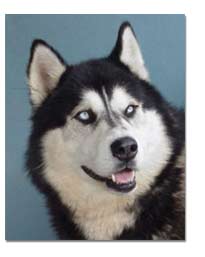 Siberian Husky Siberian Husky
Owner Level:
For experienced involved dog owners
Average Life Span:
10-14 years
Average Weight:
Male are generally 45 to 60 pounds
Females are generally 35 to 50 pounds
Average Height:
Males are generally 21 to 23 1/2 inches at the withers
Females are generally 20 to 22 inches at the withers
Color And Coat:
Coat color types ranges from: Pure white, gray, red, sable, agouti (guard hair is banded with black near the root and at the tip with a yellow or beige band at the center of the hair), jet black/white
Grooming is mainly brushing bathing etc. If you don't like dog hair, don't get a Siberian Husky. This dog is equipped with excessive fur to survive sub zero temperatures. The insulating downy undercoat sheds in early to late spring. They shed a little all year round.
Siberians also have a vairiety of eye colors. Many are spellbinding with their beauty. Eye colors: Varied hues of coppery to brown chocolate brown, icy blue, or bi-color, which is one brown and one blue eye.
Typical Health Problems:
Hip dysplasia is definitely seen in this breed but in a moderate frequency level. Eyes disorders are a seen in this breed and are all of a serious nature. The most common are: Hereditary or juvenile cataracts, corneal dystrophy, and progressive retinal atrophy, glaucoma. Each disorder occurs in a different portion of the eye, and can occur in any eye color. These disorders can result in blindness and lead to other life threatening health problems. Treatments and corrective surgeries, if possible, are costly. Yearly eye exams are a must.
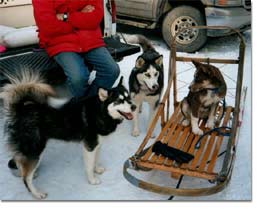 History and Personality: History and Personality:
Originally bred by the nomadic peoples of the Chukchi Tribe, of Siberia. The Siberian Husky was developed to provide transportation over the vast frozen land. This tough, strong medium size dog was able to quickly cover long distances on very little food. They were bred to have a gentle nature and were a intrigal part of everyday family life. The relationship born of mutual need and nurtured by mutual respect existed between this dog and the Chukchi people. The Siberian lived in isolation for centuries before the outside world discovered it and bought it to other regions. The present day Siberian Husky has changed a lot since entering this country around 1900, but with in the current Siberian Husky breed the heart and drive of the beloved and much prized, Chukchi dog still lives.
Today's Siberian is a beautiful, captivating, eager, outgoing, animated canine companion.They have the ability to charm and hold captive the hearts of many. Their abilities in addition to companion animals are: Sledding, carting, running companion, agility, obedience. This breed has many charms, however they also have strong and difficult behaviors that require a special effort for successful ownership.
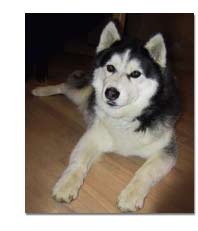 Why are these dogs typically in animal shelters? Why are these dogs typically in animal shelters?
The majority of Siberian Huskies in shelters arrive there as strays. Owner turn-ins of this breed to shelters are due to a variety of reasons. Currently, one of the most common reasons is that the owner can not, or better put, will not keep the dog home. These dogs are difficult to contain and that requires; work and financial commitment, on the owners part. Other common reasons that owners leave their Siberian at a shelter are:
Owner's inability to provide for this breed's emotional needs, companionship needs, socializing, and training requirements, and improper behaviors. Improper behaviors usually develop out of frustration, lack of proper training, and inadequate exercise and generally range from: House training, excessive activity level, digging, property damage, noise. Many owners have a clear lack of understanding of this unique breed, which results in the dog ending its days in a shelter facility. Please make sure you are in a stable life pattern before acquiring a Siberian Husky. A new baby in the house and child versus dog are also common reasons why these dogs are in shelters. Owners moving is a regular turn-in reason also. A lot of rentals and neighborhoods will not be Siberian Husky compatible. These dogs as adults are very hard to find good compatible homes for, so make sure you can make a lifetime commitment. Some Siberians arrive at shelters because of owner neglect. This breed is not for the impatient owner. Impatience, misunderstanding, and a desire by owners to make the Siberian Husky conform to, what it can not, will sometimes lead to abuse.
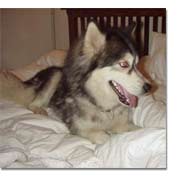 Who should own this breed? Who should own this breed?
This fun loving, affectionate, outgoing, breed requires an experienced, committed, stable owner that has educated themselves well on this breed's needs. Siberian owners should be aware of this dog's amazing natural abilities and desires. They should also know that those abilities and desires, if not channeled and use will become a problem. The Siberian Husky attracts a lot of people because of it's beauty. They are also adorable puppies and win people's hearts in an instant. Many uneducated, puppy smitten owners soon find out this is not the breed for everyone. This is a fantastic, but very specialized breed that requires a special owner to be successful.
Siberian Huskies are high energy. Always look to a dogs historical roots and modern jobs for insight. These dogs were originally bred to run in sub zero temperatures for long distances and still do. Their endurance and desire to go is not the correct match for the average pet owner. But for many Siberian owners, this breed becomes a lifelong passion of the heart and they would own no other.- They need the company of other dogs or of people at all times. If you work all day, or have room for only one dog, don't get a Siberian. Loneliness for this breed equals TROUBLE. A lonely Siberian Husky will display a full spectrum of undesirable behaviors.
- Siberian Huskies have a pretty common trait for digging holes in backyards. If you take great pride in your landscaping efforts, a Siberian is not for you.
- While capable of strong affection for his family, the Siberian Husky is also very friendly with strangers and make poor watch dogs. A Siberian will not alert his owner to strangers. They are usually pretty happy to see just about everyone. Which I see as a positive for the Siberian. An owner is not bothered with irritating barking every time someone enters or passes by his property.
- The breed in general is not good with: Cats or any small animals, rodents, birds or fowl, because of their prey drive instinct. There are of course exceptions, but don't count on it. If you desire to have or currently own such pets do not get a Siberian Husky.
 - Siberian Huskies are vocal. They rarely bark, but will whine, or moan, and also chirp and howl. Head held high, they will produce one of the most haunting song like sounds. Now this Siberian song fest may be music to the ears of a Siberian and the Siberian Husky fancier, but the neighborhood may not agree.
- Siberian Huskies shed a lot. When they blow coat in the spring it is a lot like a doggie hair storm. Brushing helps and you can speed the shedding up with a warm bath. But if you don't like fur all over the house, the car, the furniture and if you don't want to match you wardrobe to you dogs coat color, you don't want to get a Siberian.
- Siberian Huskies need a lot of exercise. They have a high endurance level and need a owner that wants to keep up with them. Huskies love to do what they were bred for, so being involved in Siberian Husky sledding, carting and other events or breed clubs is a plus for the dog and the owner. Obedience and agility are also good outlets and activities for the Siberian Husky and owner. They can make good walking/running partners, if the weather is not to warm.
- Siberian Huskies have a tremendous desire to RUN. But the very first dash that a puppy makes could be it's last. These dogs should never be allowed to run at large. They face too many hazards in today's world: Cars, other dogs, guns, poison, antifreeze. In addition, they can come in contact with diseases: Parvo, distemper, corona, parasites. The clever Siberian Husky can surely add to that list, easily. They also have a strong prey drive. A gentle family Siberian Husky, at large can inflict, death or injury to livestock, fowl, cats, and wildlife. These mis-adventures could cost you some time in court , large sums of money and ultimately cost your dog, it's life. A Siberian, for their own protection, should be kept confined or under control at all times.
- Siberians are escape artists. Some can be contained in 6 foot fencing. Others can clear an 8 foot fence like they have wings. Most Siberian Huskies require completely enclosed kennels to keep them where they are safe when they are not being supervised. Each Siberian Husky varies, but in general this breed is a lot of work to contain. The Siberian is the "Houdini escape artist" of the dog world.
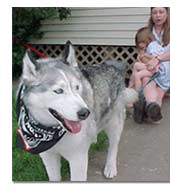 Is this breed good with children? Is this breed good with children?
Children and dogs should never be left alone and unattended, even for a moment. Young children do not have proper dog etiquette, and dogs do not understand a child's behavior. This can result in tragedy with any breed of dog. The Siberian can be a good older child companion, but that greatly varies on training, socializing and energy level. So, each dog and child relationship should be considered individually.
Is this breed good with other dogs in general?
Siberian Huskies generally do well with other dogs if they have been socialized. Generally this breed displays friendly, playful interest in most dogs. If attacked, however, they will readily defend themselves. This breed has a team or pack mentality and they prefer generally to have a human or dog companion with them at all times. Spaying/neutering is one of the most important keys to having a dog-friendly animal. Pack position and socialization is important and will affect and vary each dog's acceptance of other dogs. Huskies also have a strong prey drive and some may not prove compatible with small dogs. A small dog or any cat should not be left alone with a Siberian Husky.
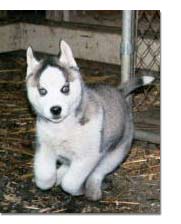 How easy is training and house training with this breed? How easy is training and house training with this breed?
Huskies are very intelligent, but are not easily channeled to jobs they dislike or have no interest in. Like humans each dog's abilities, likes and dislikes will vary. Give a Siberian Husky a job he is bred for and he will excel. Put him in obedience classes and the results will vary greatly. Training a Siberian Husky to some tasks can be painstaking, but worth the effort. Good training gives all dogs the ability to speak the same language with us. Keeping your Siberian Husky stimulated, busy and happy is the most important thing, not that he be the best at any task. The committed owner can indeed obedience train their Siberian Husky. If you are looking for a captivating, joyful, free spirited friend, look to the Siberian Husky. If you are looking for a dog with a natural desire for obedience, a Siberian Husky, is not for you.
The time required to house train a Siberian will vary depending on each dog and on the method used. Strong positive methods and consistency will work best for training with this breed. Crate training seems to be of great assistance for most dogs in housebreaking. Siberians are in general not safe to leave loose in your house unattended. Crating, if they are not being supervised, is reccommended. Do not leave a Siberian alone in your car uncrated unless you know the dog well. They, like a lot of dogs, can eat a car seat in a few minutes.
Socializing this breed?
Socialization is one of the necessary requirements to successful dog ownership. This breed thrives in dog and human activities. They need company like they need food and water. Socialization and social activity for these dogs is mandatory to maintain a happy, well balanced and almost well behaved Siberian Husky. |
|

